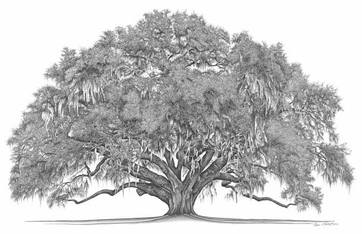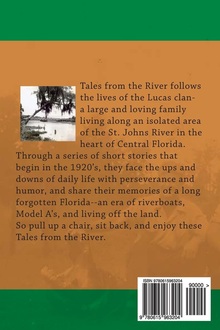Serving Astor & the River Communities of Central Florida
The Saint John's River and it's History
The Saint John's River is the longest river in the State of Florida (310 miles) and is somewhat unique in the fact that it is one of the few rivers that flows predominately in a northerly direction. It has sometimes been called "Florida's First Highway" and has a rich and diverse history. A variety of people have lived on or near the St. Johns, including Archaic people, Timucua, Mocama, French and Spanish settlers, Seminoles, slaves and freemen, Florida crackers, land developers, tourists, and retirees. It has been the subject of William Bartram's journals, Marjorie Kinnan Rawlings' and Bill Belleville's books, and Harriet Beecher Stowe's letters home.
Although Florida was the location of the first permanent European colony in what would become the United States, it was the last U.S. territory on the east coast to be developed, and it remained an undeveloped frontier into the 20th century. When attention was turned to the state, however, much of the land was rapidly overdeveloped in a national zeal for progress. The St. Johns, like many Florida rivers, was altered to make way for agricultural and residential centers. It suffered severe pollution and human interference that has diminished the natural order of life in and around the river.
The St. Johns was named one of 14 American Heritage Rivers in 1998 but was included on a list of America's Ten Most Endangered Rivers in 2008. Restoration efforts are underway for the basins around the St. Johns as Florida continues to deal with population increases in the river's vicinity.
Although Florida was the location of the first permanent European colony in what would become the United States, it was the last U.S. territory on the east coast to be developed, and it remained an undeveloped frontier into the 20th century. When attention was turned to the state, however, much of the land was rapidly overdeveloped in a national zeal for progress. The St. Johns, like many Florida rivers, was altered to make way for agricultural and residential centers. It suffered severe pollution and human interference that has diminished the natural order of life in and around the river.
The St. Johns was named one of 14 American Heritage Rivers in 1998 but was included on a list of America's Ten Most Endangered Rivers in 2008. Restoration efforts are underway for the basins around the St. Johns as Florida continues to deal with population increases in the river's vicinity.
Probably it would come as a surprise to most of the eighteen million residents of Florida to learn that this peninsula and Panhandle have the longest recorded History of any of the American States.
Our Website
The purpose of our website is to collect and display topics of historical interest about the river while complementing the efforts of the many fine historical societies located in Florida. We encourage active participation by visitors to this site and hope you will share your own stories and photographs, etc. for others to enjoy.
We recognize that the material contained in this website belongs to all of the American people and we take our role as stewards of these data very seriously. Visitors to this website should also understand that the historical and archeological locations shown in these web pages are subject to the applicable laws and regulations of the State of Florida and must be properly preserved and protected. (See links included on specific pages for information & guidance)
The website is intended to always be "a work in progess" and hopefully will continue to grow and be a useful resource in the
months and years ahead.
We sincerely hope you will enjoy it.
We recognize that the material contained in this website belongs to all of the American people and we take our role as stewards of these data very seriously. Visitors to this website should also understand that the historical and archeological locations shown in these web pages are subject to the applicable laws and regulations of the State of Florida and must be properly preserved and protected. (See links included on specific pages for information & guidance)
The website is intended to always be "a work in progess" and hopefully will continue to grow and be a useful resource in the
months and years ahead.
We sincerely hope you will enjoy it.
"Astor" Rooted in Old Florida History TM
History of the Bartram Tree
"This place has a longer History of Settlement than most of the Country. For Longer than Deland, DeBary or Daytona Beach." Florida Hisotry News Journal
In the Spring of 1774, William Bartram, a naturalist from Pennsylvania, traveled inland from the St. Johns River to the Alachua Savanna (Gainesville), Present day Hanynes Prairie Preserve. In 1772, Dr. John Fothergill had commissioned Bartram to collect the natural history specimen in the Georgia coloy for the sum of #150 per annum. Having failed on 1776 to establish a plantation put outside present day Jacksonville, Florida, Bartram had not yet made a place for himself in Life. Now at the age of thirty-five, he returned to East Florida to follow his favoirite pursuit, the study of plants and animals. The Oak Tree was planted during this time on the soon to be Dillard Property in Astor.
TALES from the River-
Recollections of Life on the St. Johns River
by the Lucas Family of Astor.
(find your Copy on Amazon.com or go to Historical Book Links above)
The Main Objectives of the St. Johns River Historical Society are:
To research, for, secure by donation, purchase or other legitimate means and processes, historical data, facts, articles, pictures, papers, books and objects of any and every kind, nature and description, related to, connected with , pertaining to, or tending in any manner to reflect the history of the Saint John's River in the vicinity of Astor, Florida and the local communities.
This will include biographical and family histories of the people residing therein, regardless of date, time, place, race color or condition, and to preserve all such for the benefit of posterity and make the same available to the public under appropriate rules, restrictions, fee, or condition as may be reasonably imposed from time to time.
To cooperate with, work with, aid and assist any person(s) interested in the Astor Area and the Saint John's River, Florida
To compile, copyright, publish, sell or otherwise distribute historical facts and data relating to the Astor area and its people, either past, present or future or relating to the local history.
To research, for, secure by donation, purchase or other legitimate means and processes, historical data, facts, articles, pictures, papers, books and objects of any and every kind, nature and description, related to, connected with , pertaining to, or tending in any manner to reflect the history of the Saint John's River in the vicinity of Astor, Florida and the local communities.
This will include biographical and family histories of the people residing therein, regardless of date, time, place, race color or condition, and to preserve all such for the benefit of posterity and make the same available to the public under appropriate rules, restrictions, fee, or condition as may be reasonably imposed from time to time.
To cooperate with, work with, aid and assist any person(s) interested in the Astor Area and the Saint John's River, Florida
To compile, copyright, publish, sell or otherwise distribute historical facts and data relating to the Astor area and its people, either past, present or future or relating to the local history.
Note: Saint John's River description above includes material credited to Wikipedia
Your WEBMASTER & Designer - Tina Hagstrom and Jeffrey White











